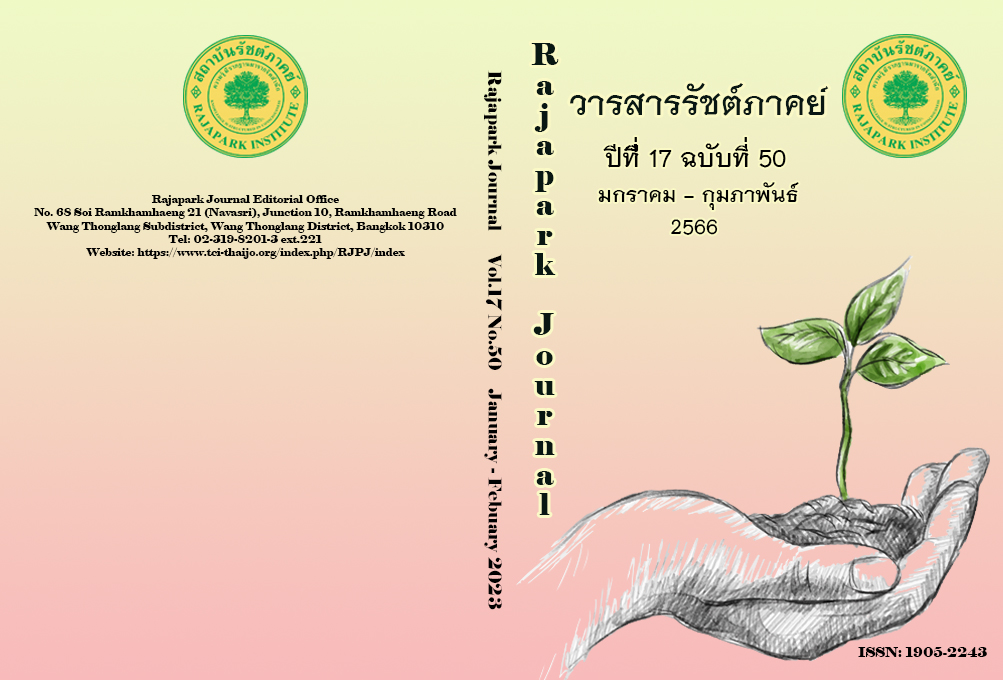Causal Factors Influencing Team Effectiveness in Schools under the Secondary Education Service Area Office Chonburi Rayong
Main Article Content
Abstract
The objectives of this research were: 1) to study the level of organizational context, team characteristic, team process and team effectiveness in schools. 2) to study the relationship of casual factors influencing team effectiveness in schools and 3) to find out the direct and indirect effects of the factors affecting the team effectiveness. The samples were 357 persons including teachers in schools under the secondary education service area office Chonburi Rayong, which were selected by stratified random sampling. The research instruments used were Likert scale questionnaires comprising 5 levels of data analysis. The statistics used for data analysis included percentage, mean, standard deviation, the Pearson product moment correlation coefficient and path analysis. LISREL was used for path analysis. The results of this research indicated that; 1) The levels of organizational context, team characteristic, team process and team effectiveness in schools were at a high level and each aspect was at a high level. 2) The relationship of inter correlations amongst causal factors and team effectiveness in schools were all significant. The casual factors correlated with team effectiveness. 3) The casual factors that had direct and indirect effects on team effectiveness in schools under the secondary education service area office Chonburi Rayong were as follow: (1) Direct effects occurred from two casual factors were team characteristic and team process. (2) Indirect effect from organizational context through team characteristic and team process toward team effectiveness in schools was significant.
Article Details

This work is licensed under a Creative Commons Attribution-NonCommercial-NoDerivatives 4.0 International License.
Views and opinions appearing in the Journal it is the responsibility of the author of the article, and does not constitute the view and responsibility of the editorial team.
References
Akakulanan, S. (2008). EQ: Personnel and Team. Journal of Social Sciences and Humanities, 34 (2), 40-54.
Borrill, C., & West, M. (2002). Team Working and Effectiveness in Health Care: Findings from the Healthcare Team Effectiveness Project. Aston Centre for Health Service Organization Research.
Bussadee, S. (2016). The Causal Relation Model of Factors Affecting Teamwork Effectiveness in Schools under The Northeast Primary Education Service Area Office[Doctoral Dissertation, North Bangkok University].
Campion, M.A., Medsker, G.J., & Higgs, A.C. (1993). Relations Between Work Group Characteristics and Effectiveness: Implications for Designing Effective Work Groups. Personnel Psychology, 46(4), 823–847. https://doi.org/10.1111/j.1744-6570.1993.tb01571.x
Campion, M.A., Papper, E.M., & Medsker, G.J. (1996). Relations Between Work Team Characteristics and Effectiveness: A Replication and Extension. Personnel Psychology, 49(2), 429-452. https://doi.org/10.1111/j.1744-6570.1996.tb01806.x
Chantasorn, T., Manoosilp, P., & Rimcholakarn, Y. (2015). Factors Affecting Team Effectiveness in Educational Institution under Loei Provincial office of The Non-Formal and Informal Education. Humanities and Social Sciences Journal of Pibulsongkram Rajabhat
University, 9(1), 109–130. https://so01.tci-thaijo.org/index.php/GraduatePSRU/article/view/55658
Charuaendet, W., Surakitbowon, S., Koomkhainam, T., & Chalakbang, W. (2016). A Linear Structural Relationship Model of Quality Teams Affecting Primary School Effectiveness in the Northeast Under the Office of the Basic Education Commission. Nakhon Phanom University Journal, 6(1), 24–33.
Cohen, S. G. (1994). Designing Effective Self-Managing Work Teams. In M.M. Beyerlein & D.A. Johnson (Eds.), Advances in Interdisciplinary Studies of Work Teams: Theories of Self-Managing Work Teams, (pp. 67–102). Elsevier Science/JAI Press.
Conley, S., Fauske, J., & Pounder, D. G. (2004). Teacher Work Group Effectiveness. Educational Administration Quarterly, 40(5), 663–703. https://doi.org/10.1177/0013161X04268841
Cronbach, L. J. (1990). Essential of Psychological Testing (5th ed.). Harper Collins.
Durham, C.C., Knight, D., & Locke, E.A. (1997). Effects of Leader Role, Team-Set Goal Difficulty, Efficacy and Tactics on Team Effectiveness. Organizational Behavior and Human Decision Processes, 72, 203-231. http://dx.doi.org/10.1006/obhd.1997.2739
Gardner, D.G., & Pierce, J.L. (2001). Organization-based Self-esteem, Generalized Self-efficacy, and Affective Reactions to the Workplace: An Empirical Re-examination. Journal of Management Systems, 13(4), 31-48.
Gladstein. D.A. (1987). Demography and Design: Predictors of New Product Team Performance. Sloan School of Management, Massachusetts Institute of Technology (MIT). http://hdl.handle.net/1721.1/2332
Goodman, P.S., Ravlin, E., & Schminke, M. (1987). Understanding Groups in Organizations. Research in Organizational Behavior, 9, 121–173.
Hackman, J.R., & Oldman, G. (1980). Work Redesign. Addison-Wesley.
Joreskog, K. G., & Sorbom, D. (1984). Lisrel VI. Analysis of Linear Structural Relationships by Maximum Likelihood, Instrumental Variables, and Least Squares Methods. Scientific Software.
Khotnarin, W., & Treputtharat, S. (2011). Factors Affecting the Effectiveness of Teams in Secondary Schools under the Office of Secondary Educational Service Area 25. Journal of Education Graduate Studies Research Khon Kaen University, 5(2), 100-106. https://so02.tci- thaijo.org/index.php/EDGKKUJ/article/view/50558/41829
Kiniman, K., Pakasat, N., & Penpokai, N. (2019). Causal Relationship Model of Factors Related to Effectiveness of Working Team in Hospitals. Human Resource and Organization Development Journal, 11(1), 1-25. https://so01.tci-thaijo.org/index.php/HRODJ/article/ view/159618
Kreitner, R., & Kinicki, A. (2004). Organizational Behavior (6th ed.). McGraw-Hill.
Krejcie, R.V., & Morgan, D.W. (1970). Determining Sample Size for Research Activities. Educational and Psychological Measurement, 30(3), 607-610.
Kwak, E.J.L. (2004). Team Effectiveness and Characteristics: Apparel Product Development Teams[Doctoral Dissertation, The Florida State University]. https://diginole.lib.fsu.edu/islandora/object/fsu:181227/datastream/PDF/view
Meesomsap, A. (2010). A Study of Relationship Between Team Work and Academic Administration of Schools under The Office of PhranaKhon Si Ayutthaya Educational Service Area 1[Master’s Thesis, Phranakhon Si Ayutthaya Rajabhat University].
Manoosilp, P. (2008). A Structural Equation Modeling of Factor Affecting Team Effectiveness in The Schools under The Office of The Basic Education Commission[Doctoral Dissertation, Khon Kaen University].
Manoosilp, P. (2015). Factors Affecting Team Effectiveness. Humanities and Social Sciences Journal of Pibulsongkram Rajabhat University, 9(2), 1–28. https://so01.tci-thaijo.org/index.php/GraduatePSRU/article/view/55699
Phao-ard, L. (2016). Team Working of Teachers in Mueang Trat Expanding Opportunity Schools under Trat Primary Educational Service Area Office[Master’s Thesis, Burapha University].
Schermerhorn, Jr. J.R. (2005). Management (8th ed.). John Wiley & Sons.
Sundstrom, E. (1999). Work Groups: From the Hawthorne Studies to Work Teams of the 1990s and Beyond. Group Dynamics, Theory, Research, and Practice, 4(1), 44-67.
Werner, J.M., & Lester, S. W. (2002). Applying a Team Effectiveness Framework to the Performance of Student Case Teams. Human Resource Development Quarterly, 12(4), 385-402. https://doi.org/10.1002/hrdq.1004
Woodcock, M., & Francis, D. (1994). Teambuilding strategy (2nd ed.). Gower Publishing.
Yeatts, D.E., & Hyten, C. (1998). High-Performing Self-Managing Work Teams A Comparison of Theory to Practice. Sage Publication. https://doi.org/10.4135/9781483328218


